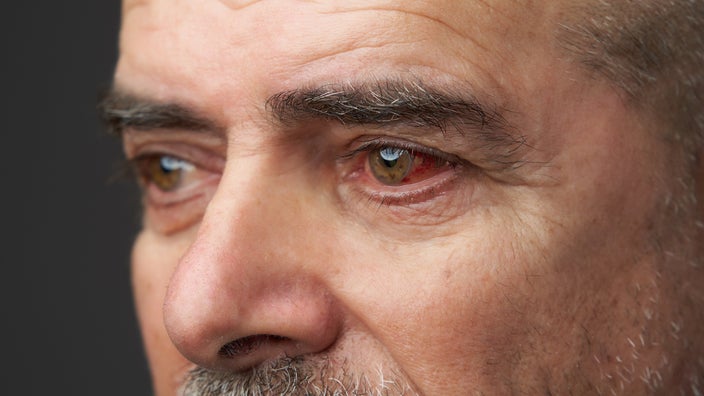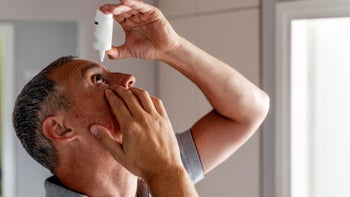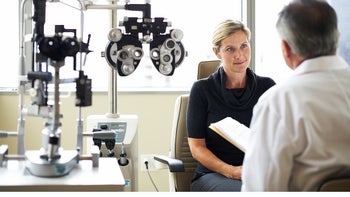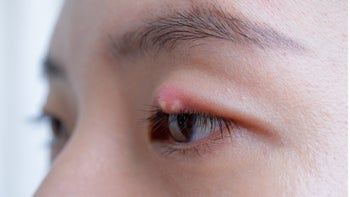
Why Are My Eyes Red? 9 Causes of Red, Bloodshot Eyes
Key takeaways:
Red, bloodshot eyes are very common. They’re usually not a cause for concern but can sometimes be a sign of an eye condition.
Allergies, dryness, and infections like conjunctivitis can all cause bloodshot eyes.
Treatment depends on what’s causing the eye redness.
Table of contents

If you’re noticing that your eyes look bloodshot, you may be wondering what’s causing your eyes to look red. Swollen and inflamed blood vessels on the surface of the eye can result in eye redness. And there are many other reasons your eyes might look bloodshot.
Here are some common causes of red eye and some treatment options. And learn about when to visit a healthcare professional about your eye redness.
What causes red or bloodshot eyes?
Some common causes of red eyes include:
Allergies
Dry eyes
Contact lens overwear
Conjunctivitis
But many other things can cause bloodshot eyes. Here are nine reasons your eyes may look red.
Medications can affect your eyes. See if your medication is on our list of medications that can harm your eyes.
Struggling with blepharitis? Blepharitis happens when your eyelids get inflamed. You can find relief with our list of the best prescription and OTC blepharitis treatment options.
Stye in your eye? Here are tips that can help you get rid of that stye for good.
1. Allergies
About 2 in 5 people experience allergies. Seasonal allergies (hay fever) and year-round allergies cause sneezing, congestion, and runny nose. But allergies can also cause eye symptoms like redness, itching, and tearing. Both eyes will usually develop symptoms. More severe eye allergies can result in draining, eye pain, and blurry vision.
It’s more common to have eye allergy symptoms along with nose symptoms. But some people only have eye symptoms without other allergy symptoms (allergic conjunctivitis). This occurs when the immune system overreacts to allergens, such as pollen or pet dander.
2. Dry eye
Dry eye is a medical condition that can cause bloodshot and/or irritated eyes. Dry eye develops when your eye cannot produce enough tears to moisten themselves. And your tears quickly evaporating can lead to the same result. This can occur when your eyes focus for long periods of time, like when you’re reading or driving.
Be prepared with Prolensa
Prolensa treats inflammation and reduces eye pain in patients after cataract surgery. Uninsured patients may pay as little as $80 copay for up to a 60-day supply.

Several things can decrease the amount of tears you make, including:
Certain medications, like antihistamines
Sleep aids
Age
Medical conditions, like Sjögren’s syndrome
Dry eye syndrome can worsen because of:
Lack of sleep
Too much time on digital devices
Poor lighting
Environmental conditions, such as dry weather, smoke, or wind
Contact lenses kept on for extended periods of time
3. Contact lens
Contact lenses limit the amount of oxygen that gets to the cornea, which is the clear front surface of your eye. This is most likely to be a problem if you sleep in your contact lenses or wear them for extended periods of time.
When the cornea lacks oxygen, inflammation and infection are more likely to occur. At first, the eyes might look red or bloodshot. But over time, contact lens overuse can lead to eye pain and/or serious infection. This includes keratitis or a corneal ulcer — both of which can lead to permanent vision loss.
4. Pink eye
Pink eye (conjunctivitis) refers to inflammation of the conjunctiva caused by an infection. The conjunctiva is a thin, clear membrane that covers the white part of your eye and lines the inside of the eyelid. In addition to redness, symptoms of conjunctivitis include:
A burning feeling in the eyes
A sense that there’s something in the eye (foreign body sensation)
Clear discharge
Eye crusting and swelling
5. Subconjunctival hemorrhage
Subconjunctival hemorrhage occurs when blood pools in the eye. This happens between the clear connective tissue on the white part of the eye (conjunctiva) and the eye’s deeper white surface of the eye (the sclera). These pools can be small or so large that they cover the entire white of the eye. Subconjunctival hemorrhages occur when small blood vessels break and leak out. This makes the eye look red. Causes can vary, including:
Eye rubbing
Straining
A strong cough or sneeze
Medications like blood thinners
But there’s good news. Subconjunctival hemorrhages are harmless and not painful. They will also usually clear up in a few weeks.
6. Episcleritis
Episcleritis is inflammation on the surface of the sclera. Episcleritis involves a part of one eye but can affect both eyes. Although it’s uncomfortable, having episcleritis isn’t super painful. Associated with it are underlying medical conditions, such as rheumatoid arthritis. Work with your healthcare professional to schedule an eye evaluation. This will help diagnose episcleritis or a deeper inflammation of the sclera (scleritis).
7. Blepharitis
Blepharitis is inflammation of the eyelids that can make your eyes look red. It has several causes, including:
Ocular rosacea, an inflammatory condition that affects the eyes
Bacterial or fungal infections
Demodex mites in the eyelashes
Red, itchy, and flaky eyelids right at the eyelash line are signs of blepharitis. It can also make your eyes look red or bloodshot.
8. Stye
A hordeolum or stye is a painful red bump, boil, or pimple that forms on the edge of the upper or lower eyelid. They are a result of blocked oil glands near the eyelashes.
Hordeola can form on the inside of the eyelid. And this can irritate your eye and make it look red or bloodshot. Treatment options include antibiotic eye creams and warm compresses. Sometimes antibiotics themselves can irritate the eye and cause eye redness.
9. Chalazion
A chalazion is usually a bump farther back on the eyelid, often caused by a scarred hordeolum. They can start with some discomfort and redness and become less painful over time. But friction from rubbing at the chalazion can lead to red eyes.
How can you prevent red eyes?
If a medical condition is causing your red, bloodshot eyes, getting the right treatment can prevent red eyes from coming back. For example, if you have allergies, avoiding allergens and taking allergy medications or using eye drops can stop eye redness.
If you’re not sure what’s causing your bloodshot eyes, some general eye care tips can help keep your eyes clear. Try these tips:
Avoid rubbing or touching your eyes. This will keep germs out of your eyes and lower your chances of developing an eye infection, like styes. It can also help prevent infections and irritation if you have blepharitis. Frequent handwashing will keep bacteria off your hands so you don’t accidentally transfer germs to your eyes.
Take care with your contact lenses. Make sure to follow all directions for contact lens care. This includes keeping them clean and changing them out per manufacturer directions. Make sure you don’t sleep in your contacts unless you have continuous wear contact lenses.
Avoid irritants. Smoke, fumes, dust, and pet dander can cause eye irritation, even if you don’t have allergies. Try to avoid these irritants whenever you can. Wear eye protection if you’re exposed to these things at work.
Rest your eyes. Give your eyes time to recover. Make sure you get enough sleep and cut back on screen time to avoid eye strain. Give your eyes a break by following the 20-20-20 rule when working on screens. Every 20 minutes, look at an object 20 ft away for 20 seconds.
How can you treat red, bloodshot eyes?
If you continue to have red eyes most of the time, talk with an eye doctor. They can help you figure out what’s causing your red eyes. And you can know how best to treat your bloodshot eyes.
Medications, such as cyclosporine (Restasis) and lifitegrast (Xiidra), can help with dry eye. For some types of conjunctivitis or hordeola, antibiotics are the best treatment. And for allergies, eye drops such as ketotifen (Zyrtec or Zaditor) or oral antihistamines like loratadine (Claritin) or cetirizine (Zyrtec) can relieve symptoms.
When should you get medical care for your red eyes?
Although red eyes aren’t always a big deal, some causes of red eyes can be serious. It can be difficult to know when to visit a healthcare professional. But any of the following symptoms should prompt a visit to your eye doctor:
Changes in vision, such as blurriness or difficulty seeing
Pain in the eyes
Severe headache
Nausea and vomiting
Fever
Unusual light sensitivity or halos around lights
Feelings of having something in your eye
Eye injury or chemical exposure
Swelling around the eye
Inability to keep your eye open
Thick pus coming from your eye
Frequently asked questions
No, not always. Red eyes can be a sign that your eyes are irritated from exposure to smoke, fumes, or other irritants. But it may be a sign of an eye condition if you frequently have eye redness or you have other eye symptoms, too.
No, red eyes don’t mean you have bad eyesight. But see an eye doctor if you’ve noticed new vision changes along with red eyes. This could be a sign that you’re developing a new eye condition.
Maybe. If you’re dehydrated, it’s possible for your body to make fewer tears. Lubricating tears keep your eyes moist. Without them, you can develop eye irritation and redness. It’s important to keep in mind that dehydration doesn’t cause dry eye, which is an eye condition where the eyes don’t make enough lubricating tears.
It depends on what’s causing your red eyes. If your eyes are irritated from a recent exposure to an irritant, like smoke, your red eyes should improve a few hours after the exposure goes away. But if a medical condition is to blame, your red eyes might not go away until you get treatment.
The bottom line
Red, bloodshot eyes are pretty common. But there’s good news. Red eyes often aren’t usually the result of serious or dangerous causes. It’s important to know the signs that indicate you need medical attention. Treatments include preventive measures, home remedies, prescription eye drops, and oral medications. You can also work with an eye specialist for further evaluation and treatment.
Why trust our experts?


References
Akpek, E. K., et al. (1999). Severity of episcleritis and systemic disease association. Ophthalmology.
American Academy of Ophthalmology. (n.d.). Sclera.
American Optometric Association. (n.d). Dry eye.
American Optometric Association. (n.d). Subconjunctival hemorrhage.
Baab, S., et al. (2024). Allergic conjunctivitis. StatPearls.
Boyd, K. (2023). What is the difference between a stye and a chalazion? Causes, symptoms, treatment. American Academy of Ophthalmology.
Boyd, K. (2024). Ocular rosacea. American Academy of Ophthalmology.
Roat, M. I. (2022). Corneal ulcer. Merck Manual.
Sjogren’s Foundation. (n.d.). Understanding Sjögren’s.
Tarlan, B., et al. (2013). Subconjunctival hemorrhage: Risk factors and potential indicators. Clinical Ophthalmology.
Yen, M. T., et al. (2024). Demodex infestation. American Academy of Ophthalmology













